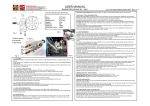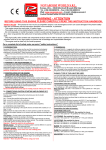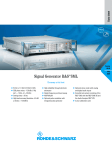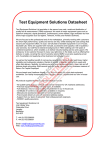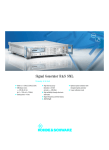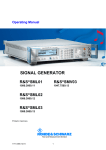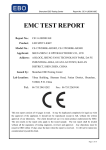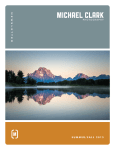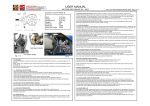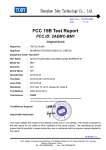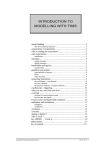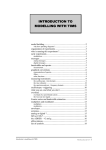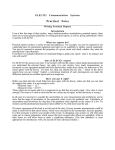Download FM Stereo Tuner Measurement
Transcript
® ® ® Products: R&S UPL, R&S UPV, R&S SML FM Stereo Tuner Measurements with Audio Analyzers R&S® UPV or R&S® UPL and Signal Generator R&S® SML with R&S® SML-B5 option Application Note RAC-0502-0012 This Application Note presents a program called FMTunerMeas, which combines FM tuner measurements to form automatically running sequences in line with DIN EN60315-4. It is an extension of Application Note 1GA43 and can be used with the Audio Analyzer R&S UPV. Subject to change – Mike Cheong, Tilman Betz 03.2006 – RAC-0502-0012 version 1.1 FM Stereo Tuner Measurements Contents 1 2 3 4 5 6 7 8 9 1 Overview ................................................................................................. 2 Stereo Frequency Modulation Theory ..................................................... 2 Hardware and Software Requirements ................................................... 5 Connecting the Computer and the Instrument ........................................ 5 Installing the Software ............................................................................. 6 Operating FMTunerMeas_demo Software.............................................. 7 Literature ................................................................................................. 9 Additional Information ............................................................................. 9 Ordering Information ............................................................................... 9 1 Overview More and more modern mobile phones and PDAs come integrated with FM chipsets. To analyze the quality of RF FM tuners, a large number of measurements have to be performed. This Application Note presents a program, FMTunerMeas, which combines automatic FM tuner measurement sequences in line with DIN EN60315-4. It is an extension of Application Note 1GA43 and can be used with the Audio Analyzer R&S UPV. The program FMTunerMeas is included. Run FMTunerMeas to perform measurements via GPIB remote control or to simulate the test sequences without any hardware connected. The report with measurement graphics and the test results are generated automatically in the appropriate folders in the user’s computer. 2 Stereo Frequency Modulation Theory In FM, the amplitude of the information signal is used to vary the carrier frequency, while the frequency of the information signal determines the rate at which the carrier frequency changes. For a transmitter with linear modulation characteristics, the frequency deviation of the carrier is directly proportional to the amplitude of the applied modulating signal. The frequency deviation is defined as follows: = k f * EM where k f (= frequency deviation/V) is the frequency sensitivity of the FM modulator and is the peak frequency deviation. Mathematical analysis of FM E fm (t ) = Ec sin( 2 f c t + m f sin 2 f m t ) The R&S logo, Rohde & Schwarz and R&S are registered trademarks of Rohde & Schwarz GmbH & Co. KG and its subsidiaries. RAC-0502-0012 version1.1 2 Rohde & Schwarz FM Stereo Tuner Measurements where Ec is the peak amplitude of the carrier frequency, fc and fm represent the carrier and modulating frequencies, and mf is the index of modulation. mf = fM where f M is the rated maximum system deviation. Pre-emphasis and de-emphasis In normal speech and music, the spectral amplitude of the signal drops at higher frequencies. This behavior can be used to improve the signal-to-noise ratio of the FM transmission. In the transmitter the higher signal frequency amplitudes are amplified. Due to the typically lower amplitudes at higher frequencies, this can be done without violating the rated maximum system deviation (RMSD). On the receiver side, this frequency-dependent amplification is compensated by a lowpass with exactly the same time constant used in the transmitter. This lowpass reduces the noise in the receiver but produces an overall flat frequency response for the desired signal, due to the preemphasis in the transmitter. FM Stereo FM Stereo Transmitter block diagram The left and right sources of information are first pre-emphasized and then fed to adder circuits. The output of one adder is the sum of the two signals (L + R), and the output of the other adder is the difference of the two signals (L H R). The L H R signal is applied to a balanced modulator driven with a 38 kHz signal. The output of the balanced modulator is a DSBSC AM signal centered at 38 kHz. RAC-0502-0012 version1.1 3 Rohde & Schwarz FM Stereo Tuner Measurements Level / Deviation Spectrum of the Stereo MPX Signal S= (L - R ) / 2 M= (L + R ) / 2 RDS Spectrum 0 10 20 30 40 50 19 38 Pilot Stereo Subcarrier (suppressed) 60 f / kHz 57 RDS Subcarrier (suppressed) FM Stereo Receiver block diagram Filter 19 kHz 38 kHz Deemphasis 19 kHz FM Receiver Output of the demodulator RAC-0502-0012 version1.1 Bandpass (23 ... 53 ) kHz Lowpass filter 4 Demodulator S Left channel L To the AF Amplifiers Matrix R M Deemphasis Right channel Rohde & Schwarz FM Stereo Tuner Measurements 3 Hardware and Software Requirements PC hardware requirements CPU: Pentium III 800 MHz or better RAM: 128 MB or more Monitor: VGA color monitor IEC/IEEE bus: NI-compatible IEC/IEEE bus interface PC software requirements Microsoft 32-bit operating system (Windows 2000/XP) GPIB driver installed CVI runtime engine VISA runtime version 2.5 or later For a document report, Microsoft Word 2000 or later must be installed 4 Connecting the Computer and the Instrument The instrument connection is set up via an IEC/IEEE bus primary address. Make sure that each instrument has a unique GPIB address. Connect the RF output of the R&S SML to the unbalanced antenna input of the tuner. Since the R&S SML has an output impedance of 50 ohm, the generator has to be matched to the tuner. Usually the coaxial 75 ohm antenna input is used. We recommend using the Matching Pad R&S RAM, which can be ordered under 358.5414.02. If the receiver to be measured is only equipped with a balanced input, an adequate balun with an impedance of 240 ohm or 300 ohm must be connected in between the R&S SML's 50 ohm output the receiver balance input. Make sure that measurements are performed with adequate grounding, e.g. to eliminate hum pick-up. Since tuners are normally not grounded and their outputs are floating, the inputs of the R&S UPV / R&S UPL should be grounded, provided a ground connection is not established via the antenna connected to the R&S SML. FM Stereo Tuner RAC-0502-0012 version1.1 5 Rohde & Schwarz FM Stereo Tuner Measurements 5 Installing the Software 1. Extract the ZIP file, FMTunerMeas_demo.zip, available for free download from the R&S website. 2. Start SETUP.EXE to install the program. Program files are copied to a directory of your choice during installation. 3. Complete the registration form to receive a registration key. 4. Enter the key code in the registration form and click “Start”. The main window for FMTunerMeas_demo appears. 5. Once the program has been registered, the registration form will not appear the next time you run FMTunerMeas_demo. NOTE: If FMTunerMeas_demo has not been registered, you can still start the program by clicking the “Start” button. RAC-0502-0012 version1.1 6 Rohde & Schwarz FM Stereo Tuner Measurements 6 Operating FMTunerMeas_demo Software Getting started: 1. Start FMTunerMeas_demo.EXE 2. Connection and instrument control setup Before you can use this software for connecting the instrument, you must configure the program to match your setup (e.g. GPIB connection), and then click the “Test Setup” button for your test configuration as follows: RAC-0502-0012 version1.1 7 Rohde & Schwarz FM Stereo Tuner Measurements 3. Run the test Before you run the test program, you should select the test procedures you want or click the “Selected All Items” button to select all the test procedures. You also can click the “Report” button that you want to add to your report files. to include the information 4. Run the simulation test You can execute this software without connecting any instruments. In order to do that, you have to enable the Simulation check box. Note: In order to run this software properly, please close the Tuner.BAS or any other BASIC program running in the R&S UPL. If MS Word is not installed in the controller PC, you can enable "Txt Format" and disable "Word format + Diagram". If you want a Word printout format with picture results, MS Word 2000 or a later version needs to be installed in the controller PC. RAC-0502-0012 version1.1 8 Rohde & Schwarz FM Stereo Tuner Measurements 7 Literature Audio Analyzer R&S UPL Operating Manual Audio Analyzer R&S UPV Operating Manual Signal Generator R&S SML Operating Manual 1GA43_0E Tilman Betz, Measurements on RF radio tuners with Audio Analyzer R&S UPL and Signal Generator R&S SML with option -B5. 1GA24_1E Klaus Schiffner, Marco Brusati, Measurements on Tuners using the Audio Analyzer R&S UPL or UPD and Signal Generator R&S SMT. 1EC 60315-4: 1997 Methods of measurement on radio receivers for various classes of emission – part 4: Receivers for frequency modulated sound broadcasting emissions. TM NI-VISA User Manual, National Instruments, available for free download: http://www.ni.com/visa 8 Additional Information For additional information or further suggestions, please contact your nearest Rohde & Schwarz office or [email protected]. 9 Ordering Information Audio Analyzer R&S UPL R&S UPV 1078.2008.06 1146.2003.02 Signal Generator R&S SML01 R&S SML02 R&S SML03 R&S SMV03 R&S SML-B5 9 kHz to 1.1 GHz 9 kHz to 2.2 GHz 9 kHz to 3.3 GHz 9 kHz to 3.3 GHz Stereo/RDS Coder (option) 1090.3000.11 1090.3000.12 1090.3000.13 1147.7509.13 1147.8805.02 Accessory R&S RAM Matching Pad 50/75 Ohm 0358.5414.02 ROHDE & SCHWARZ System & Communication Asia Pte Ltd Regional Application Center 1 Kaki Bukit View #04-12, TECHVIEW Singapore 415941 Telephone +65 6513 0475 Fax +65-6846 1090 Internet: http://www.rohde-schwarz.com This Application Note and the supplied programs may only be used subject to the conditions of use set forth in the download area of the Rohde & Schwarz website. RAC-0502-0012 version1.1 9 Rohde & Schwarz









